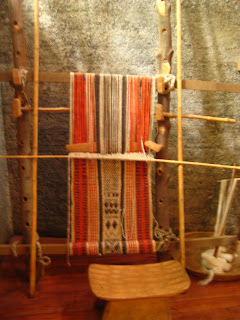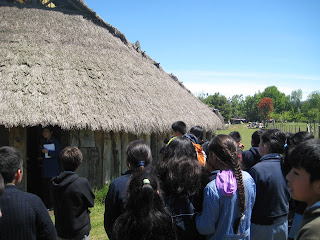In September 2010, I completed my master's program at the London School of Economics where I was awarded an M.Sc. in Social Anthropology. My research was related to gender and shamanism (physical and spiritual healing in traditional societies). Thus, immediately upon completion of my degree, I traveled to South America to conduct independent research, volunteer for a non-profit organization and learn Spanish. For three months, I lived in the Northern regions of Patagonian Chile where the majority of the indigenous Mapuche people live. I felt that this would be a perfect place to explore the topics of my thesis – gender and shamanism – since the most important Mapuche shamans are women. This photo shows a group of Mapuche machis with their healing kultruns (drums):
Drums, rose headbands and silver jewelry are very important to the machi's practice. This is one of my favorite photos showing Chilean Mapuche women in their traditional silver jewelry (still worn today). The jewelry is very culturally and cosmologically significant, and is often made for a machi only by close family members. Some machi's prefer never to take off their jewelry, even while they sleep:
In addition to this anthropological focus. I also volunteered to teach English in a school, and served as grant writer for a non-profit organization. Most challenging of all was learning Spanish from scratch upon arrival. I had never taken a lesson before, but I studied every day and by the time I left I was both pleased and surprised with how well I was able to communicate.
I traveled to Southern Chile in Region IX where the majority of the Mapuche people live today. The Mapuche are the only tribe in South America that the Spanish were never able to conquer. Chile is 3,000 miles long - about the width of the United States - and only a hundred miles wide. The area was incredibly beautiful with many lakes, mountains and volcanoes:
I organized my stay with the help of Diane (second from left in photo below) who moved from Hawaii to South America 30 years ago to set up a non-profit to help the Mapuche people. The entire organization consisted of Diane, her daughter Amor, her grandchildren, a couple from Argentina and temporary volunteers such as me. Diane asked me to come down to help her apply for funding to fulfill her dream of constructing a Mapuche Resource Center on the property. We are still eagerly awaiting to hear if the proposal has been approved.
This photo was actually taken during my last week in Chile at my going away asado (barbeque).
Amor and Diane built this cabin by hand with the help of friends and it became my home for three months. My first night there was very cold and when I woke up the temperature inside my cabin was 35 degrees Fahrenheit. I was a bit worried at first but quickly adjusted to this simple lifestyle and was actually quite sad to move out 3 months later.
My cabin was located on the edge of a Mapuche reservation where about 200 Mapuche families lived. Many rode their oxen carts or horses into town to sell their vegetables and wares on the street. It also happened to be located right beneath the Villarrica volcano, one of the most active volcanoes in the world. And shown below is little Jessica who became my best friend and companion for three months.
The nearest town of Villarrica was about 7 kilometers away. The photo shown below was taken on my first day to the town. The town (as well as my cabin) sits under the Villarrica Volcano:
This is the one stoplight in town and the town hall behind it housed the local Rotary Club:
Our non-profit organization actually had some past involvement with Rotary when Diane brought back used hospital beds from the U.S. to donate to a rural Mapuche hospital. And about 10 years ago, Diane’s daughter Amor, shown here, was asked to paint a Rotary mural. Here she is presenting the mural to the local Rotary Club president:
The mural is still located on the highway outside of town:
While I was there, I also volunteered to help with English in a rural escuela (school). This is the outside of the school, showing the building that also housed some of the students – one large room with rows upon rows of crowded bunkbeds.
Since the majority of the children came from poor Mapuche families, much of the budget was governmentally subsidized and some of the children received free meals. The founder and director of the school is also Mapuche but chose to found it as a Christian school rather than teach traditional Mapuche religion.
These are photos of me with the fifth and sixth grade (combined into one classroom) and seventh grade classes who I helped with English:
After working in the school, I saw how little the children knew about their Mapuche heritage and that none of them spoke their native language, Mapadungun. Although the Mapuche were once very proud of their culture, discrimination has caused many to begin to deny their heritage. (This is very similar to the situation with the Aboriginal people in Australia.) This loss of culture happened very quickly and many of the children no longer speak the same language as their grandparents. Thus, I developed a proposal for a school-age cultural preservation program to bring together elders and youth in a classroom setting for projects related to language, art, music, and religion to prevent the complete loss of this knowledge in the next generation. Below are some photos depicting Mapuche life, past and present:
Weaving is still a major source of income for many Mapuche families. Most Mapuche families own farms, many of which have sheep. Women are mainly responsible for the weaving and will spend an entire year making blankets to sell in the spring. In many tourist towns outside of Villarrica, Mapuche women commonly travel down from the mountains (often walking most of the way) to inexpensively sell their blankets that they worked all year creating.
Musical instruments are a major part of Mapuche ceremonies, such as the gillatun, a three day ceremony that celebrates agriculture fertility and the renewal of life.
Many of the forms and styles of Mapuche artifacts have changed very little over centuries. The masks are still in the same style but have slowly changed from stone, to wood, to metal.
The introduction of metal into Mapuche artifacts and jewelry came with the arrival of the Spanish explorers and conquerers. The Spanish brought silver coins which they traded with the Mapuche for horses and land. The Mapuche had no need for this foreign form of currency and melted the silver down to use in their jewelry and ritual objects.
Shown above are statues that imitate the style of the rewe, a step-like altar that connects the earth with the heavens/cosmos. This cosmological notion is central to Mapuche spiritual practice and many machis (shamans) heal their patients at the foot of a rewe statue.
(Photos from Museo de Mapuche, Pucon)
Based on this proposal, which challengingly enough had to be done all in Spanish, a teacher and I organized a trip for the school to visit a ruka (a traditional Mapuche stick hut) for a discussion of the old way of living and a cooking demonstration.
Here we are learning about what it is like to live in a ruka, which many Mapuche families in the mountains still do.
And before cooking, we also learned about weaving, which is central to the Mapuche way of life.
We made the dough and dropped it into the oil over the fire to make sopapillas, a type of fried bread. These are commonly eaten all across Chile.
Towards the end of my trip, I was able to spend an entire weekend staying with an Argentinian family and speaking only Spanish! The night of my arrival was their great-aunts 80th birthday:
































